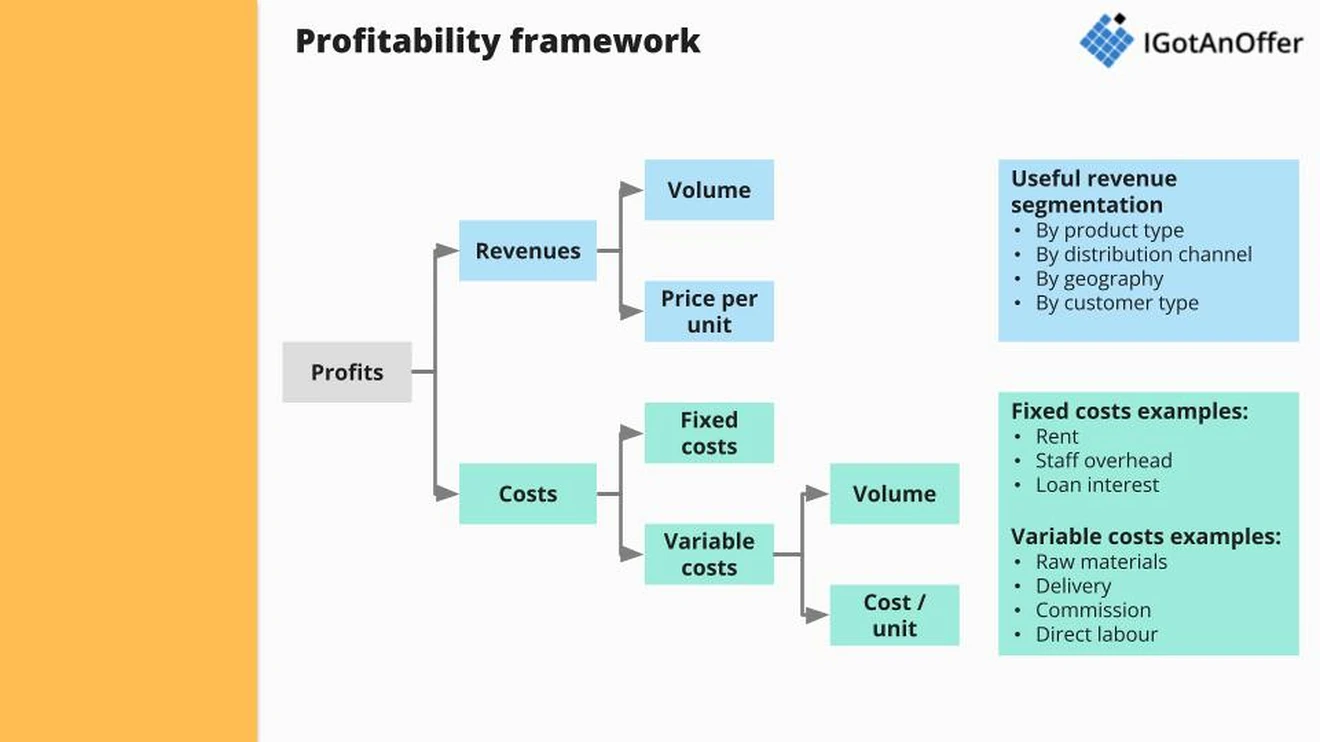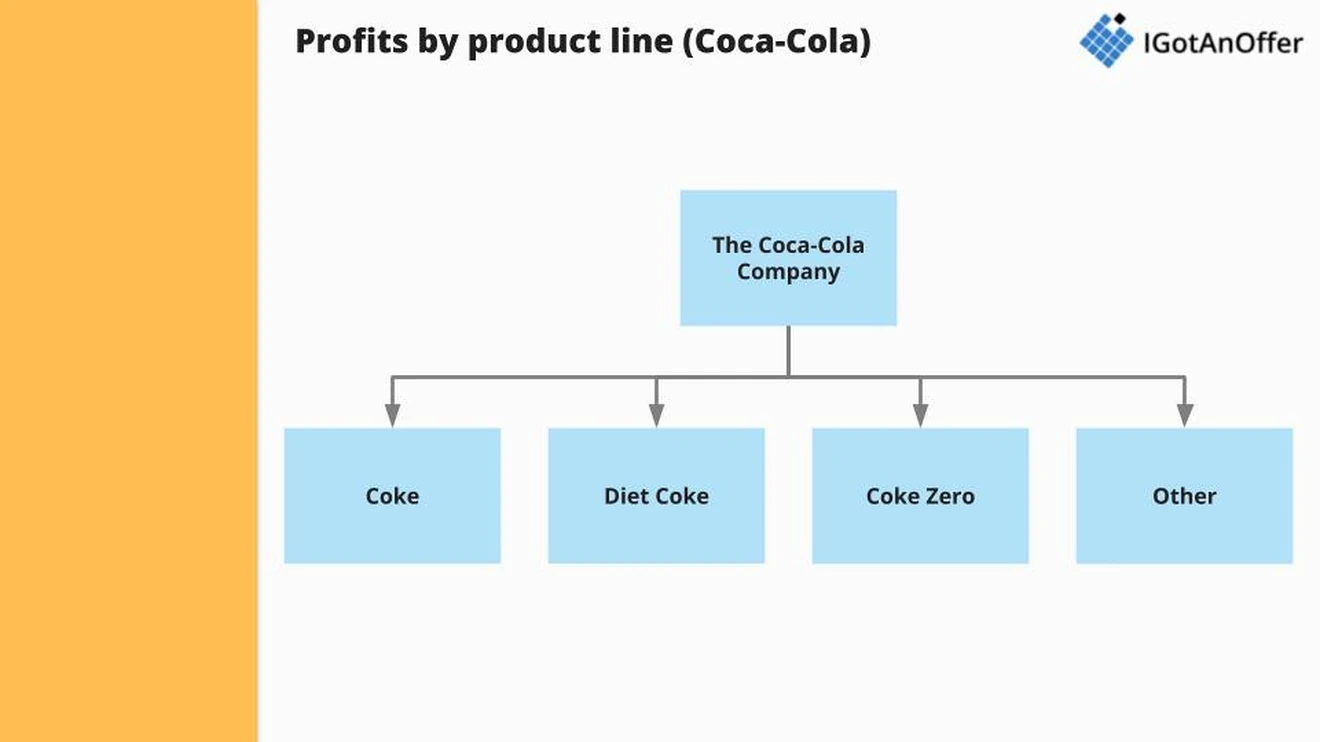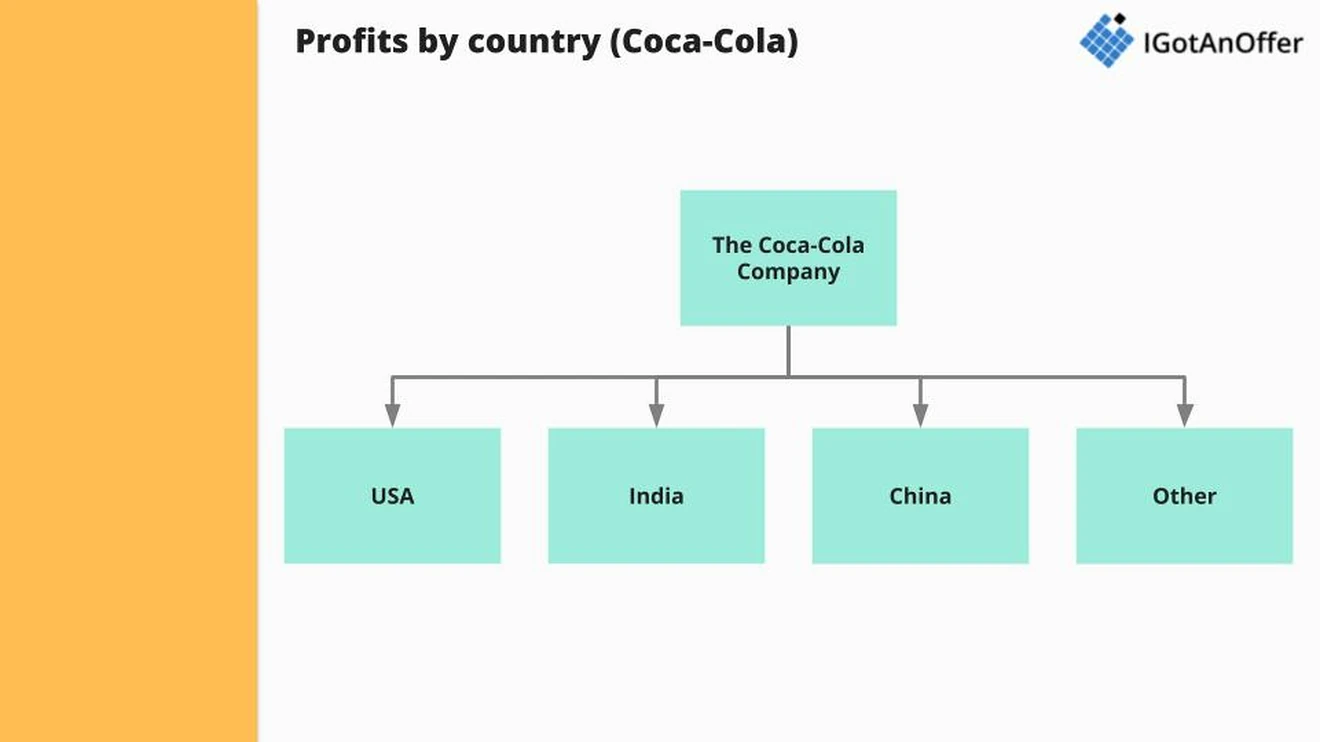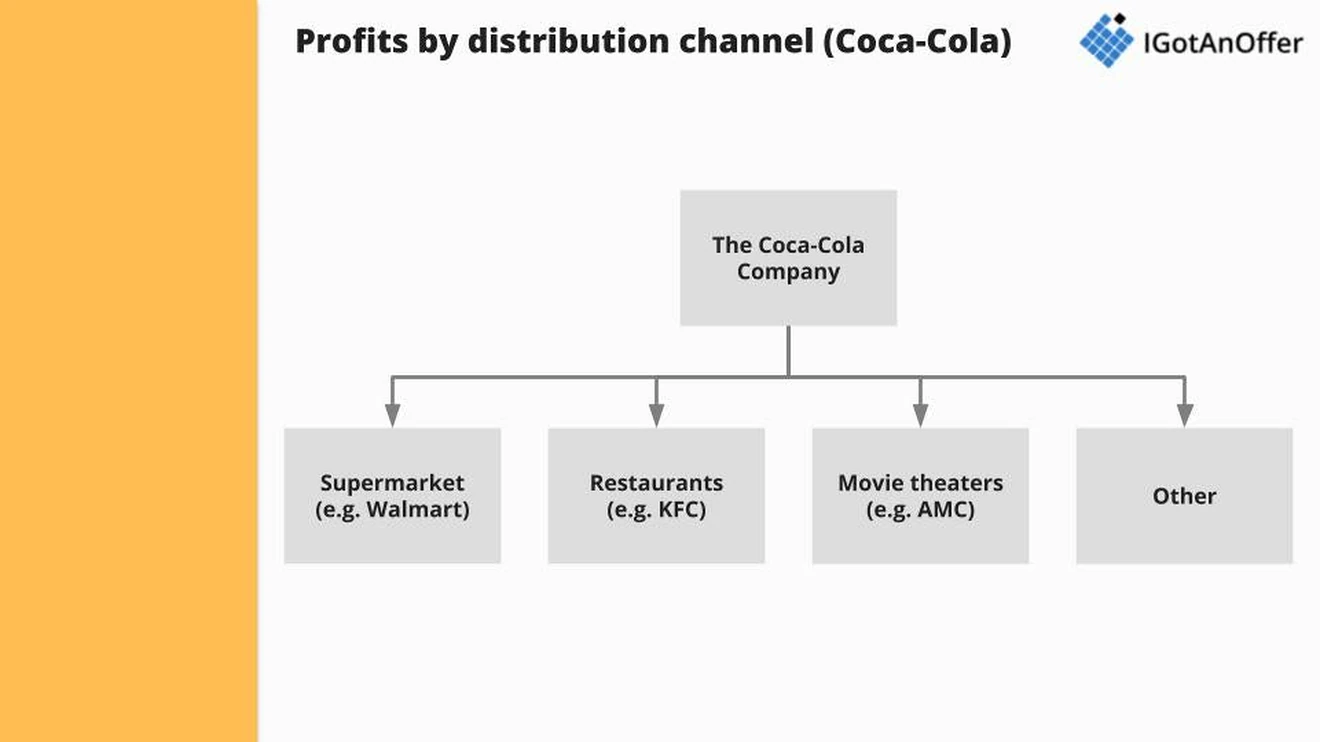MECE, pronounced "me see", is a concept commonly used at top consulting firms to talk about the approach consultants use to solve problems. Partners at McKinsey, BCG or Bain will often tell their team "I looked at what you've done. I like it but can we make this framework MECE?"
MECE stands for Mutually Exclusive and Collectively Exhaustive. Consultants usually solve clients' problems using a framework. For a framework to be MECE, its different parts CANNOT overlap (Mutually Exclusive). But they need to cover ALL possible causes of the client's problem (Collectively Exhaustive).
This is an important concept if you are preparing for case interviews as your interviewer will expect you to be aware of it. So let's cover the following three topics in this article (click to jump to the relevant section):
Click here to practise 1-on-1 with MBB ex-interviewers
1. What does MECE mean?

1.1 ME = Mutually Exclusive
The first characteristic of a MECE framework is that its different parts are mutually exclusive. In other words, there is NO OVERLAP between them. Let's imagine for a second that we are helping Coca-Cola identify the root-cause of a profit issue they are experiencing.
Here is an example a framework that's NOT mutually exclusive:
- Profits in US market
- Profits for Coke, Diet Coke and Coke Zero products
This approach is not mutually exclusive because there is an OVERLAP between the two different areas of the framework. While looking at profits in the US market, we will already analyse profits for Coke, Diet Coke and Coke Zero products. There is duplication of work across the two branches.
And here is an example of a framework that's mutually exclusive:
- Profits in the US market
- Profits in the European market
This approach is mutually exclusive because each branch in your framework corresponds to a geographical area. And there is no overlap between the different geographical areas we have chosen.
1.2 CE = Collectively Exhaustive
The second characteristic of a MECE framework is that its different parts are collectively exhaustive. In other words, they cover ALL POSSIBLE CAUSES of your client's problem. Again, let's imagine that we are helping Coca-Cola get to the bottom of a profits issue.
The framework we have used previously is actually NOT collectively exhaustive:
- Profits in the US market
- Profits in the European market
Why? Because Coca-Cola sells its products in other countries than the US and European markets. If we only look at the US and Europe, we might miss the root-cause of the profits issue which could come from another country. To make this framework MECE, we need to list all the geographies where the company sells its products:
- Profits in the US market
- Profits in the European markets
- Profits in the Asian markets
- Profits in other countries
Note that it is common to have an "Other" category in frameworks to make sure that they are MECE. This is a technique you should feel free to use in your interviews.
1.3 Why the obsession with MECE
So why are consultants obsessed with making things MECE? The answer is actually quite simple: being MECE is client-friendly.
There are three main benefits to MECE structures that clients love:
- Clean and intuitive. The first benefit is that the MECE principle forces you to create frameworks that are clean and intuitive. There is no overlap between the different parts which means it's easy for clients to focus and discuss one element at a time. You're never mixing apples and oranges.
- No risk of missing something. The second benefit is that if your framework is MECE you can't miss any causes of the issue your client is experiencing because you will cover EVERYTHING. Clients are often worried that you will "miss something" and being MECE reassures them.
- No duplication of work. Finally, taking a MECE approach enables you to make sure that there's no duplication of work in your consulting project. It means that John can cover the US market, Julie can focus on Europe, Mike on Asia, etc. Your team can organise itself in a clear and transparent way which once again clients appreciate.
1.4 McKinsey’s Barbara Minto invented the MECE principle
Barbara Minto spent 10 years at McKinsey between 1963 and 1973. She then invented a communication framework called the Minto Pyramid principle. As part of that work, she coined the phrase MECE as she wanted a shorthand to express that all the different elements of her communication framework needed to be mutually exclusive and collectively exhaustive.
2. Examples of MECE frameworks
Let’s imagine we’re working for Coca-Cola and walk through a few examples of MECE frameworks.
2.1 Profitability framework
The Profitability framework is a common MECE structure.

Coca-Cola spends money to manufacture and market drinks - that’s its costs. And the company gets revenues from customers who buy its drinks - that’s its revenues. Revenues and costs are mutually exclusive, there’s no overlap between them. And they’re collectively exhaustive because we just need these two elements to define profits.
Revenues and costs can be broken down further to expand the profitability framework. Generally speaking, maths formulas are great to create MECE frameworks. If your framework is a maths formula, it’ll be MECE by definition.
2.2 Supply chain framework
Another common framework is the supply chain or process framework. Each step in a supply chain is a separate step, and so the framework is mutually exclusive. And if the framework covers ALL the steps of the process the framework will also be collectively exhaustive.
Let's apply this approach to the Coca-cola supply-chain as an example:
- Sourcing of raw ingredients
- Manufacturing of Coke concentrate
- Shipping to local markets
- Mixing and bottling of Coke in local markets
- Distribution to retail points (e.g.: stores, wholesalers, etc.)

2.3 Other common frameworks
Let’s walk through a few more common MECE frameworks that can be used to break down profits.
Breaking down profits by product lines is MECE. Coke and Diet Coke are mutually exclusive because they’re different products. And if you include all products in your framework it’ll be collectively exhaustive.

Breaking down profits by countries is also MECE. The US and China are mutually exclusive because they’re different countries. And if you include all countries in your framework it’ll be collectively exhaustive.

Breaking down profits by distribution channels is also MECE. Retail stores and Restaurants are two different types of retail outlets. There’s no overlap between them and are mutually exclusive. And if you include all types of distribution channels in your framework it’ll be collectively exhaustive.

3. How McKinsey uses the MECE principle
Here are a few examples of what McKinsey and other consulting firms use the MECE principle for:
- Finding the root cause of problems
- Communicating in a structured way
- Designing questionnaires
3.1 Finding the root cause of problems
Here’s how McKinsey usually investigates the problems faced by its clients:
- They define the problem clearly.
- They break down the problem into MECE categories.
- They identify potential causes to the problem within each category.
- They make a hypothesis about which category the problem comes from.
- They check if their hypothesis is correct. If it is, they found the root cause of the problem. If it isn’t they update the hypothesis and carry on.
- They develop a solution to address the root cause effectively.
By systematically categorizing potential causes and progressively narrowing down the list, McKinsey is able to identify the root cause and take appropriate actions to resolve the problem.
3.2 Communicating in a clear way
To communicate with its clients, McKinsey often uses a MECE communication framework called the Minto Pyramid principle. The fact that the structure used to communicate is MECE enables McKinsey to make sure they cover all aspects of what needs to be discussed, and that there’s no overlap between the different parts of the presentation they’re planning.
3.3 Designing questionnaires
This is less common but McKinsey consultants also sometimes have to design questionnaires while doing customer research. When asking multiple choice questions to customers it's important that the options provided are MECE otherwise it can sometimes be hard to draw conclusions.
4. Preparing for consulting interviews
We've coached more than 15,000 people for interviews since 2018. There are essentially three activities you can do to practice for consulting interviews. Here’s what we've learned about each of them.
4.1 Learn by yourself
Learning by yourself is an essential first step. We recommend you make full use of the free prep resources on this consulting blog and also watch some mock case interviews on our YouTube channel. That way you can see what an excellent answer looks like.
Once you’re in command of the subject matter, you’ll want to practice answering questions. But by yourself, you can’t simulate thinking on your feet or the pressure of performing in front of a stranger. Plus, there are no unexpected follow-up questions and no feedback.
That’s why many candidates try to practice with friends or peers.
4.2 Practise with peers
If you have friends or peers who can do mock interviews with you, that's an option worth trying. It’s free, but be warned, you may come up against the following problems:
- It’s hard to know if the feedback you get is accurate
- They’re unlikely to have insider knowledge of interviews at your target company
- On peer platforms, people often waste your time by not showing up
For those reasons, many candidates skip peer mock interviews and go straight to mock interviews with an expert.
4.3 Practise with experienced MBB interviewers
In our experience, practising real interviews with experts who can give you company-specific feedback makes a huge difference.
Find a consulting interview coach so you can:
- Test yourself under real interview conditions
- Get accurate feedback from a real expert
- Build your confidence
- Get company-specific insights
- Learn how to tell the right stories, better.
- Save time by focusing your preparation
Landing a job at a top consulting company often results in a $50,000 per year or more increase in total compensation. In our experience, three or four coaching sessions worth ~$500 make a significant difference in your ability to land the job. That’s an ROI of 100x!
Click here to book case interview coaching with experienced MBB interviewers.















